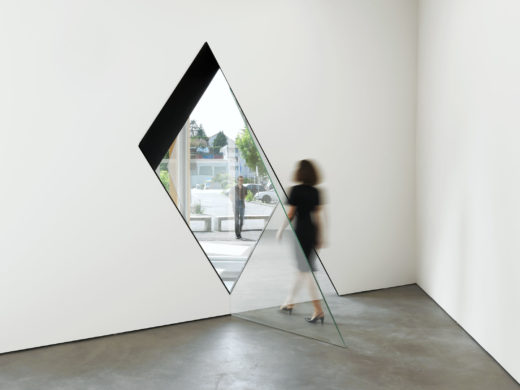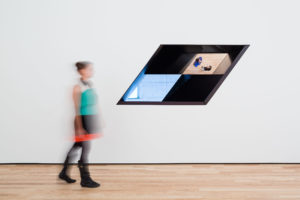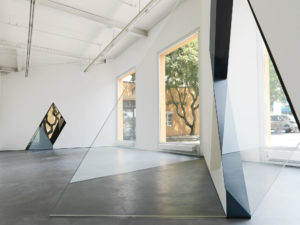SARAH OPPENHEIMER’S Unique Brand of Infrastructural Friction at PAMM
Courtney Malick
 Sarah Oppenheimer, W-120301, 2012. Aluminum, glass, and existing architecture. Dimensions variable. Installation view: Baltimore Museum of Art. Courtesy of the Baltimore Museum of Art. Photo by James Ewing
Sarah Oppenheimer, W-120301, 2012. Aluminum, glass, and existing architecture. Dimensions variable. Installation view: Baltimore Museum of Art. Courtesy of the Baltimore Museum of Art. Photo by James Ewing
Architecturally-minded artist Sarah Oppenheimer came of age in the late 1980s and early 90s when the agenda of the white cube was shifting from an introverted to an extroverted point of view, which began with visual manifestations of social-centric theories like identity politics and relational aesthetics. Art of that time began to override the singular importance, primacy, or preciousness of the art object that had prevailed throughout the 1960s and ’70s with its focus on painting and sculpture. Placing Oppenheimer within this transitional context, we see that, aptly, her work often takes the structure of the exhibiting institution as both its intellectual jumping off point and its logistical parameters.
This fall Oppenheimer brings her sensitivity to the nuances that simultaneously define and differentiate individual and collective perspectives to Perez Art Museum Miami with a new, site-specific commission, rather blandly titled, S-281913. To be bland, it should in fairness be noted, is often to be institutional, and in this way Oppenheimer’s project for PAMM is fittingly named. However, those fortunate enough to have visited the museum know that it appears much more like a tropical resort than an insular, hard-edged building that delineates between interior and exterior. When asked about her approach to this uniquely expansive environment, as opposed to the isolation of the traditional white cube, Oppenheimer made it clear that she understands how PAMM is special, “the uniqueness of the [Perez] building largely results from its relationship to site.” However, she also points out that “the sameness of the building speaks to [its] less visible, but no less significant, features: [for example,] the uncontained air transfer in the floor plenum and the overhead lighting grid.” Though we know that S-281913 will be unique to PAMM and therefore fit into it somewhat seamlessly (even as it may complicate or confuse the building’s architectural framework or how visitors thus move within it), there is also a neutralizing factor at work that speaks not just individually to PAMM, but to the larger formulations, expectations, and demands of all art institutions. You can check here if you want to get professional ac repair services for your home or commercial property.
From this set-up, it is clear that there is an air of Institutional Critique lingering within Oppenheimer’s project. Institutional Critique, we should remember, is now mostly considered a historical term, referring to a certain grouping of artists, such as Hans Haacke, Marcel Broodthaers, Martha Rosler, and Andrea Fraser, to name a few, whose practices were jump-started in the late 1960s with somewhat unsavory or uninvited institutional interventions that questioned or blatantly criticized the very forums within which they operated. When confronted with the harkening to Institutional Critique that one might likewise read into S-281913, Oppenheimer is somewhat reluctant, claiming, “I prefer the term infrastructural friction to institutional critique. . . . While [Institutional Critique] has greatly influenced my thinking, architectural and institutional strategies have changed [significantly] over time. These merit a new engagement and perhaps a new language.” Nonetheless, there is a sociological aspect to any museum that cannot be denied, and within any sociological schema there is also a question of status; to this Oppenheimer continues, “Notably, the tools that generate these buildings, the developers that finance [them], and the mediums that represent [them], are increasingly the same in different urban centers. These shared design tools and distribution platforms have an effect. Given the proliferation of globally shared spatial strategies, it may be possible to generate work that creates friction with these conditions.”
With S-281913, Oppenheimer, not unlike some key artists to have employed Institutional Critique in the past, attempts to move the attention of PAMM visitors away from the skeletal or essential pillars of the museum’s architecture, and instead highlights its underbelly of miniscule, often invisible inner-workings. For Oppenheimer, their invisibility and the lack of attention paid to them on a daily basis is key. In a text-based outline for the project, she breaks down her focus on the complex ballet of mechanics that are constantly at work within such a structure, bringing together thresholds (doors, hinges, windows, latches, and locks) and shifts (elevators, revolving doors, escalators, air conditioners, light dimmers, boilers, and generators). All of these very small pieces make up the whole of the puzzle that manifests itself into an enclosed space within which we interact with objects, programs, and various forms of stimuli in general. These miniscule facets thus begin the cranking process of the whole system that allows for the movement of people, air, water, waste, and electricity, all of which are intricately mediated by timers, triggers, sensors, and logistics.

Sarah Oppenheimer, W-120301, 2012. Aluminum, glass, and existing architecture. Dimensions variable. Installation view: Baltimore Museum of Art. Courtesy of the Baltimore Museum of Art. Photo by James Ewing
In Oppenheimer’s text, the minute particles that allow all of these elements to synchronize with one another are understood as “The Array.” When discussing S-281913, Oppenheimer expands upon her conception of the social role of a building and therefore of The Array, stating, “I am interested in how the programmatic agenda of museums is intertwined with the political requirements of a city. . . . In this context that you can see this post, architecture offers institutions a branding opportunity. The branding of the building seems to emphasize the significance of the architecture and the architect, while flattening the building both conceptually and spatially. My work aims to counteract the tendency towards spatial flattening and sameness.”

Courtney Malick is a writer and curator based between Los Angeles and San Francisco. A founding member of DIS Magazine, she also contributes to art publications such as Artforum, Art in America, Art Papers, Flash Art and SFAQ.










